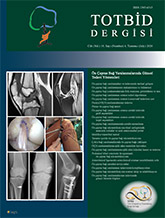
Anterior cruciate ligament (ACL) ruptures in knee-joint are one the most frequent injuries; however, it is commonly reported that there are still problems in terms of obtaining natural dynamic knee function using the current surgical reconstruction methods. The aim of anatomic ACL reconstruction is to restore normal anatomy and perfect knee kinematics. The failure in restoring full rotational stability in knees injured with ACL supports the idea that ACL reconstruction surgeries necessitates the addition of the procedures such as extra-articular tenodesis reconstructions, which aim to strengthen the structures in the lateral part of the knee. Anatomically, these clinical observations arouse the interest in doing studies which aim to examine the structural content of the structures in anterolateral part of the knee and its stabilizing contributions. As a result, some research has been done, which can be called the rediscovery of the structure anterolateral ligament (ALL) including its detailed examinations. In addition, the close relationship between ACL ruptures and ALL injuries and the association of residual anterolateral rotational instability in pivot shift test have led to an increase in the interest of the anatomic and structural features of ALL. ALL was first indicated by Segond in 1879, in his study when he described the extension of iliotibial band (ITB) during internal rotation. Segond described this structure as a pearly, fibrous band. However, the study which aroused the main interest in the anatomy of ALL was carried out by Claes et al., and there was news in written and visual media during that time stating that `a new ligament was discovered in the knee`. It is clear that to understand the instability patterns after ACL reconstruction procedures, more scientific researches needed. Further anatomical, biomechanical and radiological studies will clarify the underlying pathologies. The aim of this article is to investigate the clinical anatomy of anterolateral ligament and its biomechanical and radiological features.